In the Soviet period sign languages in this region were highly influenced by the Russian language and the old Georgian dactyl alphabet was totally based on the Russian one, with only a few additional specific letters.
The idea of creating a new original Georgian dactyl alphabet came form the local community of deaf and hard of hearing people and I was honored to work together with these people on this project. The creation of a new original dactyl alphabet based on Georgian letters was a natural step for Georgia and consistent with the sign language nationalization developments in the post-Soviet linguistic space.
This paper presents the results of our work: the new Georgian dactyl alphabet. This alphabet is one-handed with the dactyls which are easy to create and to move between. The method of processing is a mixed type and it is a letter-dactyl (non-syllabic) alphabet by the principle of marking.
In the presented papers we also display the theoretical base and the main principles for the dactyl alphabets and the 10 rules of dactiling.
Deaf and hard of hearing people use dactyl (manual) alphabets to communicate, to fingerspell proper nouns and/or clarify words or names. Dactyls (from Greek Δáκτνλοı "fingers") are the letters of the fingerspelling or manual alphabets displayed by certain handshapes. As Geilman, notes, "The manual alphabet is always in you — it is in your hands and also serves as a tracing-paper of the native language" (2003:25). The dactyl alphabet is also used in lip-reading, where dactyls help the understanding of words correctly (Davidenko & Komarova, 2006:148). Dactyl-contacting communication uses a different set of signs — dermography and tactic alphabets, which are used by deaf-blind people who communicate via touch. Touching the proper places on the hands has the meanings of certain letters.
There are about 40 dactyl alphabets in the world (Zaitseva, 2004:12). All these alphabets more or less repeat the alphabets of their own spoken languages. Significantly, unlike any other alphabets, dactyl alphabets are not used for written communications though there is so called notation — the sign-writing systems used for written communications for sign languages of deaf and hard of hearing people. Usually the sign languages can display whole words with one sign, while one concrete position of the hand is considered only one dactyl. One can observe the identical dactyls with different meanings in different alphabets. The reasons for this may be:
- As dactyl alphabets are calquing the alphabets of spoken languages, the letters may be repeated following the corresponding graphemes;
- The possibility of producing the one-handed dactyls is limited, and this limitation is very obvious in comparison with unlimited possibilities for graphemes.
According to Geilman there are the three criterions for the classification of dactyl alphabets:
- its consistence dactyl alphabet may be:
- One- handed (Such as American, Russian);
- Two-handed (such as British, Australian);
- Combined (such as Italian).
- The second criterion is the method of processing, which can be:
- Referencing or pointing;
- Copying;
- Mixed.
- The third criterion is the principle of dactyl-marking:
- By letters;
- Syllabic (such as Korean and Japan alphabets);
- Mixed (Geilman, 1981).
Our researchers changed and expanded the five rules of dactilation by Geilman (2003:25):
- "Dactilation by one hand (either right or left one) is generally accepted;
- Dactilation is conducted steadily and smoothly;
- During the time of dactilation the arm is bent in the elbow, the hand is at the level of shoulder, the palm is away from oneself so that both fingers and lips could be simultaneously visible;
- When dactiling we look at the face and the hands of the person we are talking to;
- Fingers "produce" letters according to the rules of dactilation." (Geilman, 2003:25)
We made changes to the first rule taking into consideration that there are two-handed dactyl alphabets too. We also removed the last rule and added six new rules. Finally we have 10 rules for using dactyl alphabets:
- For one-handed alphabets dactilation by one hand (either right or left one) is generally accepted;
- The dactyls should be exposed equally and dynamically, steadily and smoothly;
- During the time of dactilation the arm is bent in the elbow, the hand is at the level of shoulder, the palm is away from oneself so that both fingers and lips are simultaneously visible;
- The dactiling person looks at the face of the communicator;
- The orthography of the language should conform to existing standards. (For example: the word Tbilisi in the dative case (tbiliss - dat) has a double -s at the end and therefore the last dactyl s should be repeated twice);
- After the each word formed by dactyls there should be a pause;
- Pauses should be of standard length. The dactyls should be performed clearly, with equal short pauses between them, and bigger pauses between words;
- Articulation and facial expressions mimic should accompany the dactyls;
- During the production of dactyls the right hand moves to the left;
- In cases when a mistake is made a whole word should be repeated.
In the Soviet period, sign languages in this region were highly influenced by the Russian language. Georgia is typical in that, many active members of the deaf community are non-Georgian native speakers and during the Soviet period there were no books about Georgian sign language. The Russian influence is easy to find in the lexical units and in the old Georgian dactyl alphabet, which was totally based on the Russian one. In practice this means that many deaf people can communicate in this "Soviet sign language" and they would like to keep this possibility. However the process of nationalization has begun everywhere in the post-Soviet region and sign languages are reintegrating creating their own dactyl alphabets and providing the scientific researches of their own national sign languages. Besides Georgia such processes take place in many other former Soviet republics, such as Ukraine, Byelorussia, Estonia, Lithuania, Latvia, Moldova, and so on.
The old Georgian dactyl alphabet, which the deaf community still uses was based on the Russian one and has only a few specific letters added:
Russian dactyl alphabet
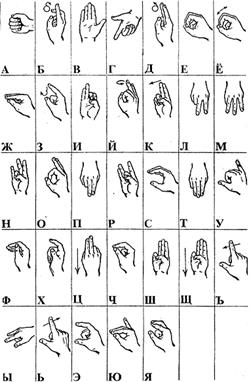
Georgian dactyl alphabet (old)

Georgian has been written in a variety of scripts over its history. These alphabets are: Asomtavruli (capital letters), Nuskhuri (or Nuskha-khutsuri) and Mkhedruli. Asomtavruli and Nuskhuri are the old alphabets and Mkhedruli is the modern Georgian alphabet, which is in use today. According to sources of the 11th century (Leonti Morveli) the first Georgian alphabet was created by the first King of Caucasian Iberia (also called Kartli), Pharnavaz, in the 3rd century BC. However, the first examples of that alphabet, or its modified version, date from the 4th-5th centuries CE. During the centuries the alphabet was modernized. The modern Georgian alphabet—Mkhedruli has 33 letters. The number of sounds is equal to the number of letters: we read as we write. (Makharoblidze, 2009:3). The Mkhedruli and Asomtavruli alphabets provided a great case for creating an original Georgian dactyl alphabet.
Together with the local deaf community we created a new Georgian dactyl alphabet. Actually this is the first Georgian dactyl alphabet. First, we developed the theoretical base and identified the main principles. The theoretical foundations are: first, the dactyl alphabet shouldn't have the similar of identical dactyls for different letters, and second, each dactyl should have its own unique representation by fingerspelling;
- Dactyls should be easy to produce / fingerspell;
- Usually the right hand forms the dactyls, but the dactyls should be easy to form by the left hand as well, keeping the mirror asymmetry;
- Preferred - if the dactyl repeats the graphical form of the same letters from the modern spoken Georgian alphabet;
- Advantaged—whether a dactyl can be produced by three fingers taking into consideration possible finger gaps or other physical problems;
- One-handed dactyls are preferred over two-handed ones;
- Mixed type alphabets (with one- and two-handed) are not preferred and to ensure consistency we avoided this form in our alphabet keeping a unified system;
- We allowed the formation of parallel dactyls (i.e. more than one dactyl that explains the same thing) as in the long process of the development of Georgian sign language the people using it will naturally choose the better alternatives.
The outcome of this process was the development of a new Georgian dactyl alphabet. It is one-handed, the method of processing is mixed type and it is a letter-dactyl (non-syllabic) alphabet by the third criteria - the principle of marking. We also tried to keep an easy dynamic for the dactyls, in the other words we tried to ensure that the dactyls were easy to physically form and could easily flow from one to another.
The advantages of our alphabet are the following:
- It has original, clear and easy forms;
- In the most cases the alphabet copies the corresponding letters from the modern Georgian alphabet Mkhedruli and below we expose the new dactyls with the corresponding letters from Mkhedruli. The flowing dactyls are repeating the graphics of the same letters: a, b, g, d, e, v, z, t, i, m, n, o, s, t', p, k, ğ, q', š, č, c, Ʒ, č. k' fully copies the corresponding letter from the old Georgian alphabet Asomtavruli, whilst t and q' dactyls partly repeat the graphics of the same letters from Asomtavruli. Some dactyls only partly copy the corresponding letters — c', h, l, r.
- Some dactyls include phonetic information as well. In our alphabet all five vowels are open, except the old version for the dactyl a - which has the form of a closed fist repeating the Russian dactyl. Phonetically as a vowel it should be open and not closed. We did design an alternative dactyl — an open one. However the Georgian deaf community preferred to use the old dactyl as for them it is as a symbol of unity amongst deaf people — as this dactyl also appears in many other dactyl alphabets. In the future local deaf community may come back again to discuss this issue.
The closed sounds are marked properly: b, g, d, m, n, p'; - The ideogramic dactyls have taken into consideration the cultural and well known elements of Georgian reality: k' — k'argi (good), n — nek'i (little finger), p' — p'irjvari (face-cross), j - jvari (cross), x - xeli (hand), q' — q'urebi (ears), c-cek'va (dance). ž is a sensitive-emotional form with nervously bended fingers.
- There are no identical or similar dactyls in this alphabet. Each dactyl is clearly different;
- The new Georgian dactyl alphabet doesn't repeat the dactyls from the other dactyl alphabets. There are only a few exceptions and the each case has its own reason and explanation. For example, as we told above, the dactyl a stays as a symbol of unity of deaf and hard of hearing people.
Twenty-four dactyls fully copy the same letters from the Georgian alphabet and four dactyls partly copy the corresponding letters. Seven dactyls are ideograms and two among them are copying the corresponding letters at the same time. This totals all thirty-three dactyls.

We left this dactyl 1 following the wish of the local deaf community. Only a few changes were made: the thumb is raised and one can see the Georgian "a" on the hand — the open part of the palm paints this letter. This was an additional reason to leave this dactyl in the same form.

This is our version of an open sound — vowel "a." The dactyl is copying the corresponding letter from the modern Georgian alphabet. Four fingers are extended together and are bent a little and the thumb is extended with a palm facing left, repeating the graphics of the letter "a".
This is a closed form of the same dactyl from the old dactyl alphabet. We left it as it graphically copies the same letter "b" from the Georgian alphabet:
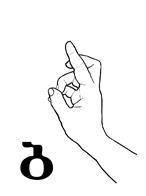
The palm faces left, the middle and the index fingers are exposing the upper part of the grapheme "b", while the other fingers are closed in a fist producing a dactyl of a closed sound.

This is an alternative version of the dactyl "b" - the closed form. The palm is facing left, the four fingers are bent a little and the thumb touches the middle part of the index finger. The dactyl copies the handwriting variant of the same letter "b" from the Georgian alphabet.
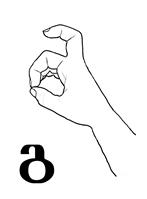
This dactyl has a closed form copying the corresponding letter "g" from the modern Georgian alphabet. The palm is facing left, the index finger is curved and raised up. The middle finger, ring finger and the little fingers are curved together and the thumb touches the middle finger forming the flattened O.
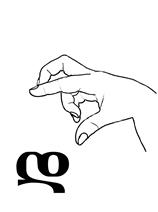
This dactyl has a closed form partly copying the same letter "d" from the Georgian alphabet. The palm is facing down, the index finger and the thumb are extended, the middle finger with its top is touching the top (nail) of the index finger, the ring finger and the little fingers are curved.
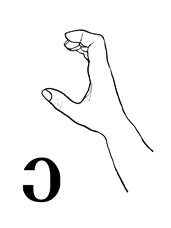
This dactyl has an open form copying the same letter "e" from the Georgian alphabet. The palm is facing left the fingers are bent in C.

This dactyl has an open form copying the corresponding letter "v" from the Georgian alphabet. The palm is facing left the thumb and the index fingers are exposing the modified C, while the other fingers are curved, creating an open circle.
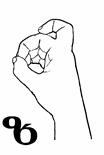
This dactyl has a closed form copying the same letter "z" from the Georgian alphabet. The palm is facing left. The middle finger, the ring finger and the little fingers are curved together and the thumb touches the middle finger producing a closed circle; the index finger is curved touching the middle part of the middle finger, producing another smaller closed circle.

This dactyl has a closed form copying the corresponding letter "t" from the Georgian alphabet. The palm is facing left and down. The index finger is bent and the thumb touches it, while the other fingers are bent in a fist. This dactyl was inserted in the Russian dactyl alphabet as a specific Georgian dactyl and we left it in our new alphabet, as it repeats the forms of Mkherduli and partly Asomtavruli as well.

This dactyl has an open form copying the same letter "i" from the Georgian alphabet. The palm is facing down. The four fingers with an extended thumb are exposing the modified C facing down. However when we worked with deaf people we found that this dactyl is not easy to produce and that it may be difficult to use this dactyl during the fluent communication. We therefore developed another version for this letter:
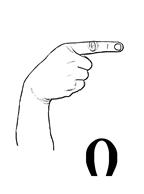
This dactyl copies the handwriting form of the same letter "i" from the Georgian alphabet. The index finger is extended showing the horizontal line, the other fingers are bent in a fist and the palm is facing the body.
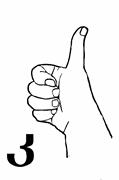
This dactyl has a closed form partly copying the same letter "k'" from the old Georgian alphabet Asomtavruli. The palm is facing left. The thumb is extended and the other fingers are bent in a fist. At the same time this dactyl references the word "k'argi"- good and this is the same sign (for the word "good") in many different sign languages.
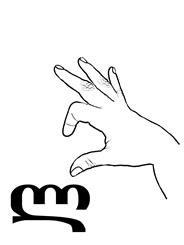
This dactyl is not a closed one. The palm is facing left, the thumb and the index finger are exposing the modified C, the middle finger, the ring finger and the little fingers are extended — like the three baskets of the printed "l" from the Georgian alphabet, partly copying it.

This dactyl is a closed form with the palm facing left. The index finger is curved and raised up, while the other fingers are bent in a fist copying the graphic of the same letter "m" form the Georgian alphabet.

This dactyl is a closed form with the palm facing left. The little finger is curved, while the other fingers are bent in a fist copying the graphic of the same letter "n" from the Georgian alphabet. At the same time this dactyl is referring the word "nek'i" - the little finger.
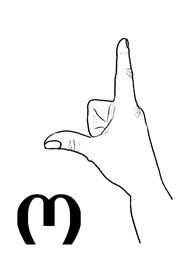
It is an open dactyl with an extended thumb and an extended index finger. The other fingers are bent in a fist. The dactyl copies the hand-writing "o" from the Georgian alphabet. The palm is facing left.
The same dactyl could be produced as an absolutely open form with the other fingers extended together with the index finger:
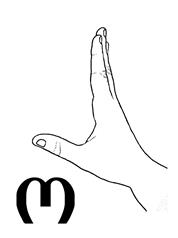
It is an alternate form of handshape for the same dactyl "o".
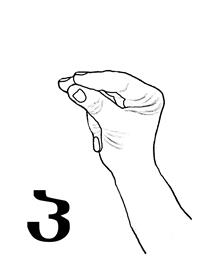
This is a closed dactyl "p'". The three fingers: the thumb, the index finger and the middle fingers are touching each others' tops in a position as if they are ready to cross something. In Georgian orthodox churches people cross themselves with this position of fingers. The ring finger and the little fingers are touching the palm.
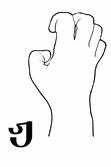
This is not a closed dactyl. "ž" is formed with the palm facing forward and all five fingers curved sensitively, nervously. From another angle (the opposite side) this dactyl looks like the following:

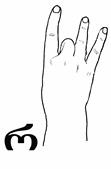
This is not a closed dactyl with the palm facing forward. It is partly copying the letter "r" from the Georgian alphabet and because of this reason we kept if from the old dactyl alphabet. The index finger, the ring finger and the little fingers are extended, while the thumb is touching the top of the middle finger.
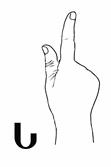
This dactyl is copying the same letter "s" from the Georgian alphabet with a mirror asymmetry. The index finger and the thumb are extended up and the palm is facing forward. The other fingers are bent in a fist.
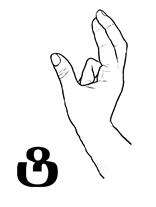
This is a closed dactyl. The palm is facing left. The thumb is curved; the index finger and the middle fingers are crossing each other while the others are touching the palm. This dactyl is copying the letter "t' " from the Georgian alphabet. It has another open version fully repeating the graphic of the same letter from the modern Georgian alphabet:


This is an open dactyl. The palm is facing left and down. The fingers bent as flattened C producing a fissure.
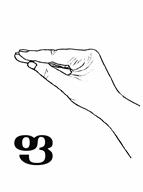
This is a closed dactyl. The palm is facing left and down. The four fingers are bent and the thumb is touching the index finger, partly copying the same letter "p" from the Georgian alphabet. This dactyl is also transferred from the old Georgian dactyl alphabet.
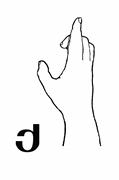
This is an open dactyl. The palm is facing left. The thumb is curved, the index finger is extended and the other fingers are curved repeating the graphical form of the same letter "k" from the modern Georgian alphabet Mkhedruli. There is an alternative version for this dactyl, as it was in the old dactyl alphabet: the thumb and the index fingers are performing the modified C, while the other fingers are extended:
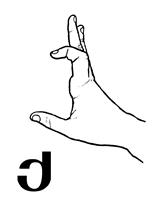
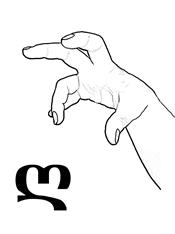
This is an open dactyl copying the same letter "ğ" from the Georgian alphabet. The palm is facing down. The index finger and the middle fingers are curved creating the upper part of this written letter and the other fingers are freely curved creating the lower part of the letter.
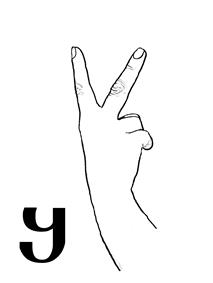
This closed dactyl is copying the same letter "q' " from the Georgian alphabet. The palm is facing the body. The index finger and the middle fingers are extended while the others are bent in a fist.
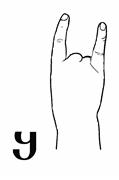
This is an alternative version of "q' ", a closed dactyl copying the same corresponding letter from the Georgian alphabets - Mkhedruli, and Asomtavruli. The palm is facing forward. The index finger and the little fingers are extended while the others are bent in a fist. This dactyl also refers the word "q'urebi" - ears.
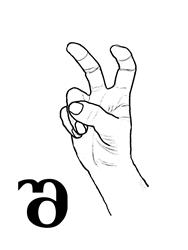
This closed dactyl is copying the same letter "š" from the Georgian alphabet. The palm is facing left and /or forward. The index finger and the little fingers are curved, while the other fingers are bent in a fist.
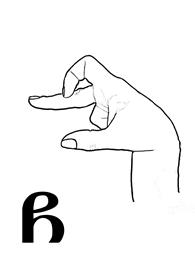
This dactyl is copying the same letter "č" from the Georgian alphabet. The palm is facing left. The middle finger and the thumb are extended; the index finger is touching the middle part of the middle finger producing a little circle, while the other fingers are bent in a fist. This dactyl has another form as well:
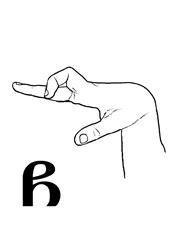
This dactyl "č" repeats the general form of the previous one, but here the ring finger and the little finger are extended together with the middle finger producing an open dactyl.
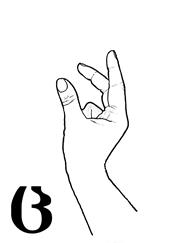
This is a closed dactyl. The palm is facing left. The thumb is curved, the index finger is extended and the middle finger is bent forward. The ring finger and the little finger are touching the palm. The dactyl partly copies the same letter "c" from the Georgian alphabet. It also has an alternative version, where the ring finger and the little finger are extended and come together with the middle finger.
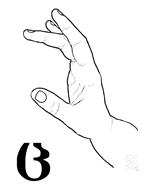
In this version it's an open dactyl with the palm facing left. This form fully repeats the letter "c" from the Georgian alphabet and at the same time refers the word "cek'va" — dance, and the dactyl mimics the shape that a Georgian ladies' hand takes in traditional Georgian dancing.

This is a closed dactyl with the palm facing left copying the letter "Ʒ" from the Georgian alphabet. The index finger is extended and the other fingers are bent producing a circle by touching the thumb. This dactyl was kept from the old alphabet, where it was inserted as a specific Georgian dactyl.

This closed dactyl with the palm facing left partly copies the letter "c' " from the Georgian alphabet. The ring finger and the little fingers are extended while the other fingers are bent in a fist.
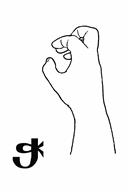
This is an open dactyl. The palm is facing left. The dactyl copies the letter "č' " from the Georgian alphabet. The fingers are curved and the middle finger is raised up and curved.
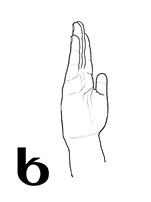
or

This is an open dactyl "x". The palm is facing forward /or left. All the fingers are extended referring the word "xeli" - hand.
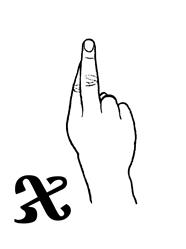
This is a closed dactyl "j". The palm is facing forward. The index fingers and the middle fingers are crossing each other while the other fingers are bent in a fist. This dactyl refers the word "jvari" - cross.

This is a partly copying dactyl exposing the three parts of the letter "h" from the Georgian alphabet. The palm is facing forward. The thumb, the index finger and the middle finger are extended and the ring finger and the little finger are touching the palm.
Georgian dactyl alphabet 2
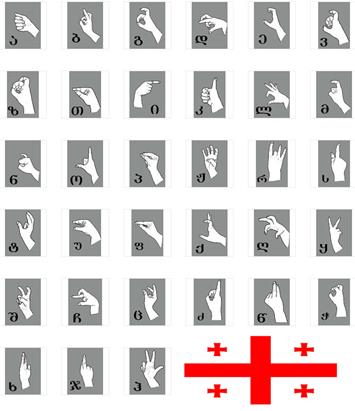
Some lexical signs, which are formed by the combination of dactyls and signs, will be changed following the changes to the dactyl alphabet and implementation of a new alphabet. This process will be reflected only on the lexical level of the language.
Usually the implementation of any type of novelty always meets some resistance. However, as this alphabet was developed together with the community of the target audience and in a close collaboration with deaf and hard of hearing people, 3 we hope that these barriers will be significantly reduced. This new alphabet is not something dictated by government or some other body, it is instead a product of the work and dedication of all interested parties most importantly those who will use it on a daily basis. As elsewhere the implementation of the new alphabet will take time. 4 The creation of a new original dactyl alphabet based on Georgian letters is consistent with changes in sign languages in post-Soviet space. In post-Soviet time the sign languages have been reintegrated and nationalized in many countries in this area.
In the world there are more than 5000 spoken languages, but only a few original alphabets. There are more dactyl alphabets than there are graphic alphabets as many nations, which do not have their own original graphic alphabets, have created their own dactyl alphabets. The Georgian alphabets (Mkherduli and Asomtavruli) provided a great base for creating an original Georgian dactyl alphabet with some national-cultural values. The question about the wide usage of this alphabet and its implementation in the educational system is a matter of time.
Works Cited
- Andersson, Yerker 1994. Deaf people as a linguistic minority. In: Ahlgren, Inger and Hyltenstam, Kenneth (eds.), Bilingualism in Deaf Education. (International Studies on Sign Language and Communication of the Deaf, 27) Hamburg: Signum. pp.9-13.
- Batatunashvili, Amiran."molaparak'e xelebi". qartuli jesturi enis leksik'oni.("The talking hands" Dictionary of Georgian Sign Language) Tbilisi. 2008
- Bazoev, Vladimir, and Plamenni, Viktor." Chelovek' iz mira t'ishini" A man from the world of silence. "Аĸaдем ĸнигa"" "AМосĸв a. 2002
- Charlotte Baker-Shenk, and Dennis Cokely. American Sign Language. A Teacher's Resource Text of Grammar and Culture. Clerc Books. Gallaudet University Press. Washington D.C. 1980, 1991
- Davidenko, Tatiana, and Komarova, Ana. "K'rat'k'i ocherk' po lingvist'ik'e Russkogo jestovogo iazik'a" (A short article about Russian Sign Language) In "Sovremennie aspek't'i jestovogo iazik'a" Ed. by Ana Komarova. Moscow, 2006 pp.146-161
- Dennis Cokely, Charlotte Baker-Shenk, American Sign Language. A Teacher's Resource Text on Curriculum, Methods and Evaluation. Clerc Books. Gallaudet University Press. Washington D.C. 1980
- Elaine Costello. American Sign Language Dictionary. Random House Webster's. NY. 1994
- Geilman I.F. Gesture Languages of Friendship. Volume II. Saint-Petersburg. 2003
- Geilman I.F Dak't'ilologia (Dactylology). Leningrad. 1981
- Gregory, Susan. The language and culture of deaf people: Implications for education. Language and Education 6: 1992. pp.183-197.
- Kendon, Adam. "Human Gestures" In K.R. Gibson and T. Ingold (eds) Tools, Language and Cognition in Human Evolution. Cambridge: Cambridge University Press. 1994
- Makharoblidze, Tamar. "jesturi enebi". (The sign languages) The works of Georgian Language Institute #2 TSU. Tbilisi. 2012. pp. 159-171
- Словaрь Руссĸого жесmоеого языĸa. Авторсĸий ĸоллеĸтив : Бaзоев В. З. Гaв Риров a Г.Н. Егоров a И.А. Ежов a В.В. Д aв ыденĸо Т.П. Чaушьян Н.А. Мосĸв a. Изд. "флинтa" 2009
- "Sovremennie aspek't'i jestovogo iazik'a" Ed. by Ana Komarova. Moscow, 2006
- Zaitseva, Galina. "Jestovaia rech. Dak't'ilologia". (Sign speech. Dactylology.) Vlados. Moscow. 2004
Endnotes
- We display the new dactyls with the corresponding letters from the modern Georgian alphabet Mkhedruli. It gives a clear view for comparing the dactyls with the same letters.
Return to Text - We exposed the Georgian dactyl alphabet with the national flag of Georgia on the bottom right. This form was finally accepted by the Georgian deaf Community in May 2012 and they prepared this picture as well.
Return to Text - I would like to say thank you to the deaf community of Georgia for this great support and collaboration, particularly to my deaf friends Natia and Lali Japoshvilis for their work and dedication and to Parkhad Abasov, who painted these dactyls. For their important contributions I'd like to express my deep gratitude to The Union of the Deaf of Georgia and its president Amiran Batatunashvili - an expert-source, a native-speaker of Georgian sign language and the vice president Maya Metonidze.
Return to Text - We have made the significant first steps and we hope the stakeholders of the educational system in Georgia will support this initiative, an initiative - which was originally proposed by the Georgian deaf people.
Return to Text

